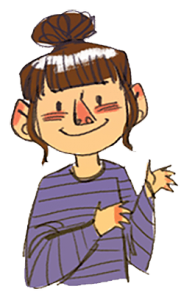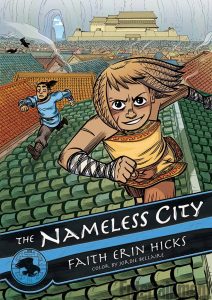Last year I went to San Francisco as a guest of the Alternative Press Expo (APE). While there, I was invited to visiting VIZ Media, publisher of some of my favourite manga (like Monster and Fullmetal Alchemist), which was really exciting. I enjoyed getting the chance to get a peek into one of my favourite publishers, especially a manga publisher. VIZ filmed me chatting with Mark de Vera about making comics, manga, and other (hopefully) interesting things. The video is pretty short, about 12 minutes, hope you guys enjoy it. (If I say so myself, my hair looks amazing, I should straighten it more often. ;))
Big news today! The cover for The Nameless City book 1 has been revealed over at Entertainment Weekly! There’s also a short interview with me as well as two non-sequential pages from the comic.
Entertainment Weekly: Exclusive cover reveal: Faith Erin Hicks’ Nameless City comes to Comic-Con
Making Comics: A day in the life …
freeglassart asked: Hello! I’ve wanted to ask… you draw a lot! Like, a lot a lot. You’re super productive (by my standards) and its all great quality stuff. Now I’ve asked a couple of people about this but I’d really appreciate getting an answer from you… Do you ever get the feeling of being tired of drawing as a whole? Like “ugh I REALLY HAVE TO finish this but I just– I just don’t want to!” And if so… How do you deal with that feeling? Many thanks!
So this is pretty much my work day:
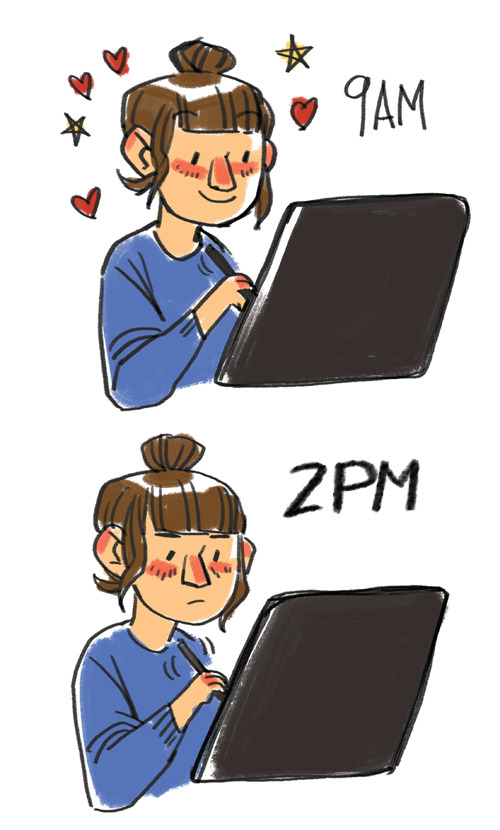
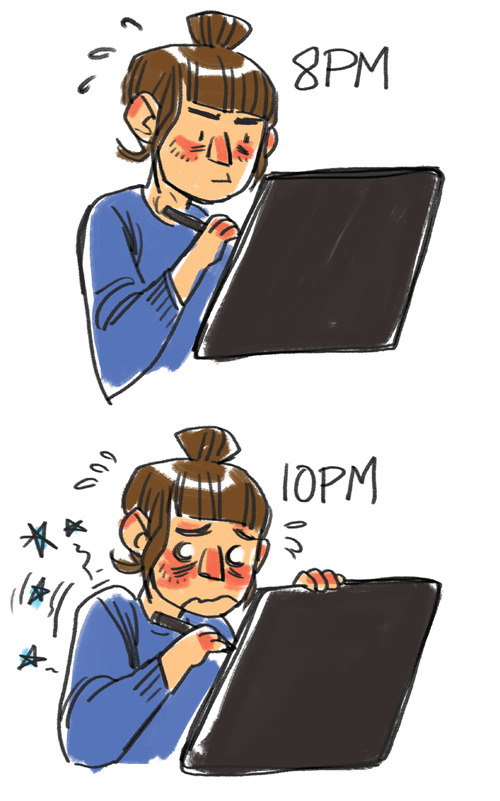
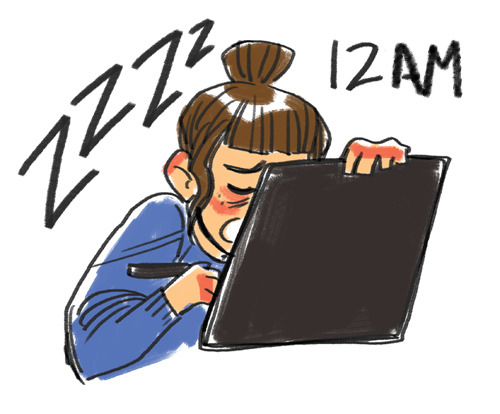
Yes, some days I really do work those kind of hours. Most days I try my best not to, but when crunch time happens and I have a deadline looming, the hours get really long. And here’s the unfortunate reality of being a professional artist: you will absolutely have moments when you are sick of drawing, when you can’t stand the idea of putting another line down on your Cintiq (or paper, or whatever), where you feel like all inspiration has been squeezed out of you and …. well, those deadlines are still looming, so you just have to keep drawing. You gotta be a pro, you gotta get your stuff drawn.
Drawing comics is my favourite thing in the world. It is my dream job. I don’t think I will ever want to do anything else, but I still have days when drawing is a drudgery. I once heard drawing comics compared to “being force fed your favourite food every day,” and I totally get that. After I’m finished drawing a graphic novel, I usually don’t want to draw at all for a few weeks after.
Burnout is definitely a thing in comics. I recommend having some hobbies that aren’t related to drawing or comics in order to combat it. I like reading, jogging and playing video games. Going out and seeing people is also super important. Anything that gives you a break from the drawing desk.
But … sometimes, the deadlines are just too tight. You don’t have time for a break. You just have to keep going. If you’re lucky enough to draw comics for a living, you should absolutely treat it as a job and try your very hardest to make your deadlines. During the final push to get Nameless City book 1 drawn, I had 3 days off over a 3 month period. I hope I’ll never have to do that again, but that was just what happened this year. I took a week off after the book was done. I slept a lot. Played Resident Evil: Revelations. Didn’t draw at all. It was nice. 🙂 I absolutely believe in keeping a work/life balance, but … well, sometimes you just gotta give up on life for a few months in order to make a deadline. And then you schedule your coming year so that you won’t have to go through that again. 🙂
nirwastir asked: Hi Faith! I saw what you wrote on hours spent on writing vs. drawing comics and I realized I’ve never actually seen a comic book script before. Does it look like a movie script? Could you tell us a bit about what scripting a comic is like?
I started writing the script for Nameless City book 2 this week, so I am totally prepared to talk about this!
DISCLAIMER! I’m going to give you a peek into how I write comics. This is a method that works for me, but it may not work for you. You don’t have to write this particular way, this is just how I do it. I’m friends with many people who work in the comic book industry and what I’ve discovered by talking to them about process is that we all make comics differently.
So, this is me, working away on the script for Nameless City book 2 this week:
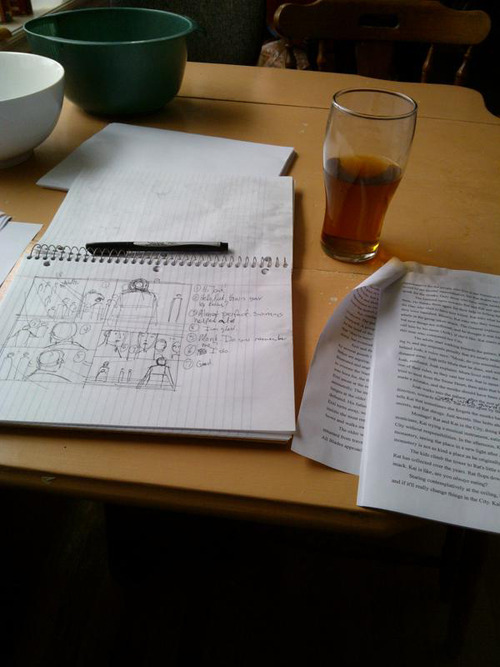
(Your bowls, kitchen table and beverage choice may vary.) The typed pages on the right are my outline. For me, an outline is important. It’s how I keep track of what needs to happen in the story. Mine tend to also have emotional beats (Kai is feeling angry because [reason], Rat is hungry because she’s always hungry) and some important dialogue thrown in. On the left is a spiral notebook purchased from a drugstore. That’s where I draw my rough draft of the book. When making my first draft of a graphic novel, I thumbnail and write dialogue by hand beside the thumbnails.
Why? Because this allows me to think about the artwork and pacing of the comic while writing dialogue. Comics are both art and writing (one does not take precedence before the other), and this thumbnail-and-script method allows me to keep the balance of both at the beginning.
When I’m done my very rough thumbnail draft, I end up with something that looks like this:
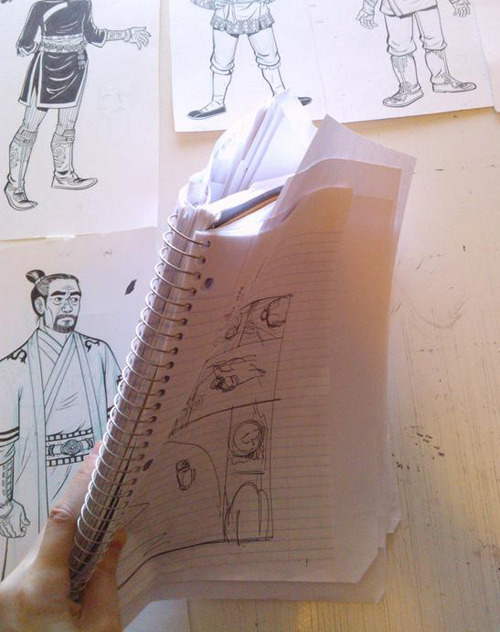
lol! That’s the first draft of The Nameless City book 1. All the loose paper is scenes I’ve added or altered, and I wasn’t able to fit them into the spiral notebook. If I was smart, I’d do these early drafts on loose paper or notebooks that allow you to add and remove pages, but I dunno, I just like these cheap spiral notebooks for some reason. XD
Then, when I’m satisfied with this early draft of the comic, I go and type the whole sucker up. It looks approximately like this:
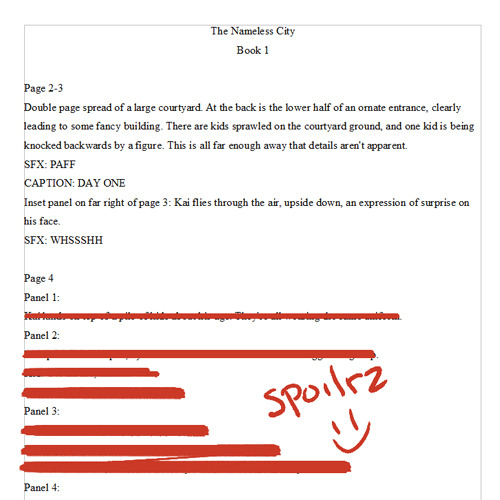
So here’s where we get into the whole thing of “I am both the writer and artist of this comic, so I work a little differently than if I was just the writer.” As both the writer and artist, I have a mental picture of what will be going on in each scene in my head (I’ve also done those thumbnails). So I’m not very detailed when describing what’s going on in each panel. I tend to include only basic, important information in addition to the dialogue, so my editor can understand what’s going on.
In contrast, here’s a page from the script for Bigfoot Boy 3, a kids’ comic series I did with the writer J. Torres. J, by the way, is an experienced and skilled writer, and very good to work with. As an artist, I recommend him!
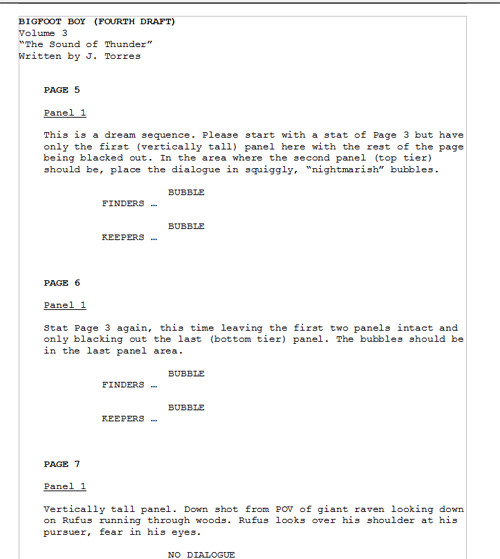
J is a LOT more detailed in his writing than I am, and there’s a reason for that: he’s not the artist of the comic, I am. And I can’t see into his head. So he has to effectively communicate what he wants drawn in each scene. That’s super important! J also formats his pages properly, which is something I can’t be bothered with if I’m writing for myself (my editor at First Second doesn’t seem to mind). I believe this is a format you can get from that writing program Final Draft (which I do not own but should probably buy at some point). I do all my writing in Open Office, a free program.
So that’s pretty much it, I think! I do a bit of revising when I type up my script, tightening the dialogue and just trying to give things a final polish, and then I hand it into my editor. She gets back to me with notes, we revise, and then I’m off to draw the sucker.
How I make the comics
I’ve been asked a few times how my comic making process works now that I’ve switched to penciling digitally, so I’m going to do a write up about that. As always you can find all my blogging about making comics on this handy tumblr post.
So, previously I made comics completely traditionally. Here’s a write up of how I used to make comics. All of the pre-drawing of the comic still applies: I still do my thumbnails by hand, scribbled in a notebook.
Now I draw comics on a Cintiq, in Manga Studio. Here’s what my initial desktop looks like:
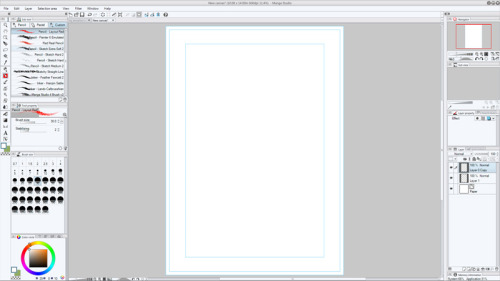
That’s Manga Studio, and my template comic page. It’s 10 by 14 inches, and the blue lines are my safety, trim and bleed. All important artwork and dialogue/speech bubbles should go within the safety.
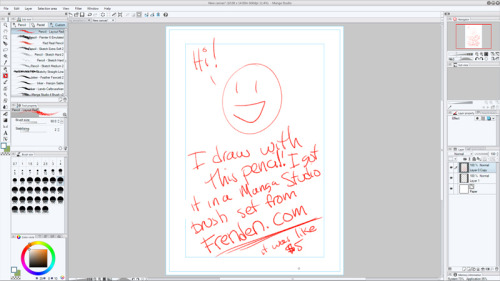
I draw with a red pencil (Pencil-Layout Red) from the Frenden Manga Studio brush pack. I can’t remember which pack I bought, but there’s only 3 on the Frenden site and I’m sure they’re all great. Frenden does great brushes. Why red? It’s just easier to see than blue. For some reason I have a hard time sketching with a blue pencil on a screen, although I still draw with blue on paper. I don’t know why that is.
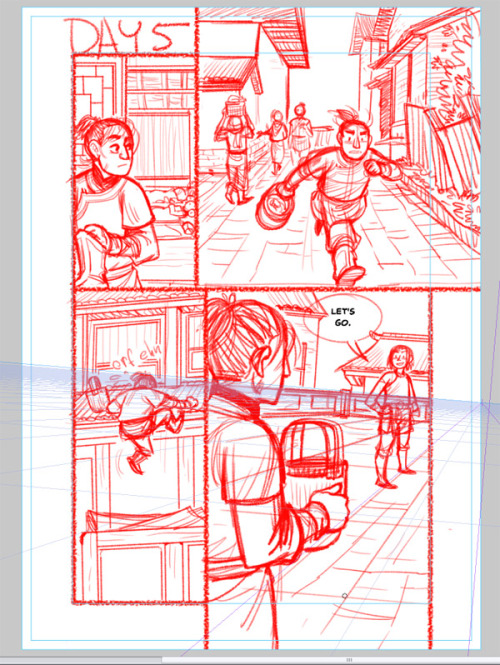
And here’s a rough comic page! Ta da! It’s pretty messy. I used a lot of reference to draw Nameless City. This is page 97, so a right facing page in the published book. Therefore the bleed on the second panel is bleeding off of the page and not into the spine of the book.
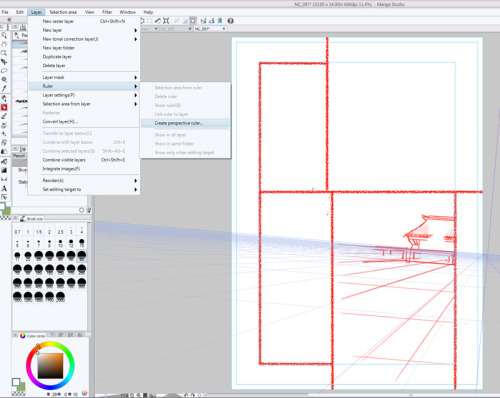
One of the best things about Manga Studio is its perspective tools. I’m not an expert in using them, so I recommend looking up someone who really knows what they’re doing if you want to know more. I mostly just use the 1 and 2 point perspective grids to figure out where the floor is in certain panels, so I can more easily place characters within space. Very basic stuff, but it has made my life so much easier. I would marry Manga Studio’s perspective grids if I could. 😀
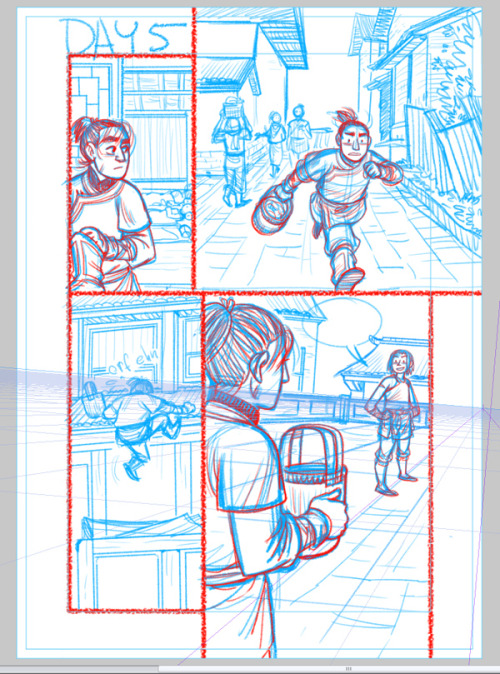
Then I clean up the page a bit. Eventually I hope to eliminate this step, because it’s time consuming. All I do is adjust the colour of the pencils to blue and trace over the figures I feel need improving with red. I usually only do this with main characters, an attempt at keeping everyone consistently drawn (lol).
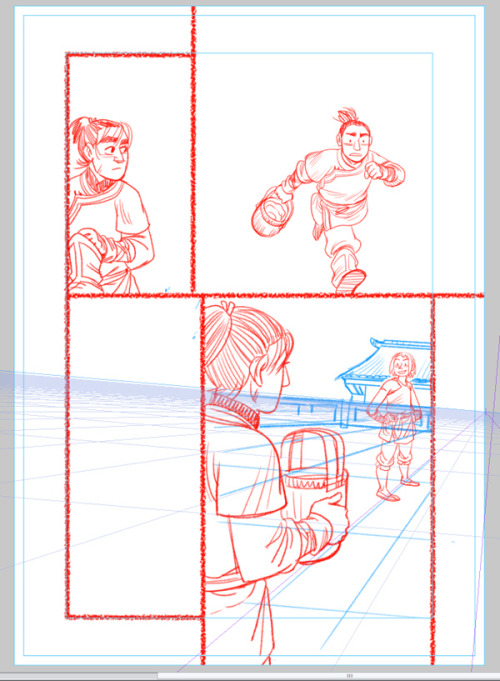
This is what it looks like with the rough pencils turned off. I never had to do this when I drew traditionally, and I think it’s because I’m not yet used to inking over digital pencils. People ask me about inking and how I “find the right line” to ink, and the answer is I just do. But for some reason I can’t with my printed out digital pencils. So until I become more accustomed to them, I need to do clean up. It sucks! Just an extra step I want to eleminate.
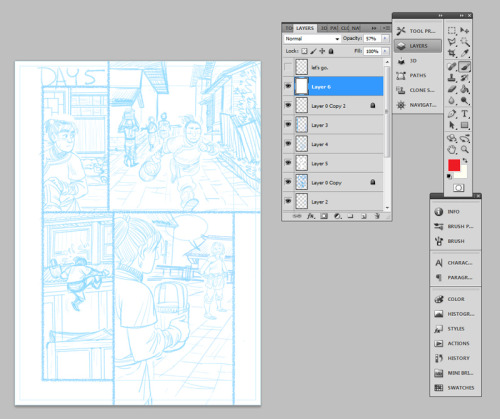
Then I bring the file into Photoshop and prepare it for printing. The pencils always print darker than the look in PS, so I put down a layer of white overtop the pencils and adjust the layer’s opacity to 55%.
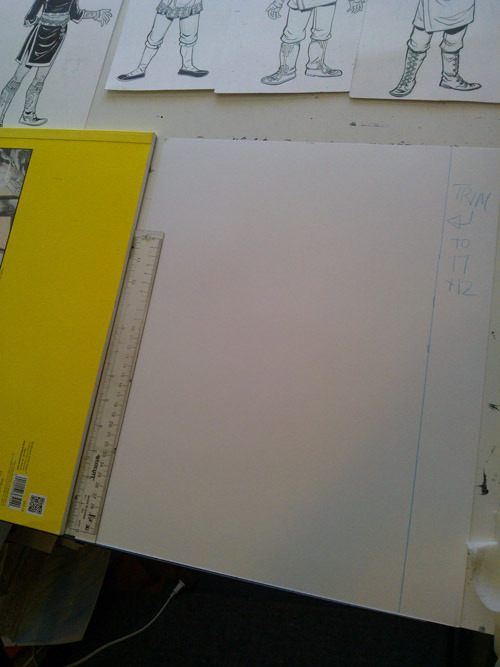
Here’s the paper I use for printing, same paper as I’ve always used: Strathmore Bristol, smooth surface. I cut down these 17 x 14 inch sheets to 17 x 12 so they’ll fit in my printer.
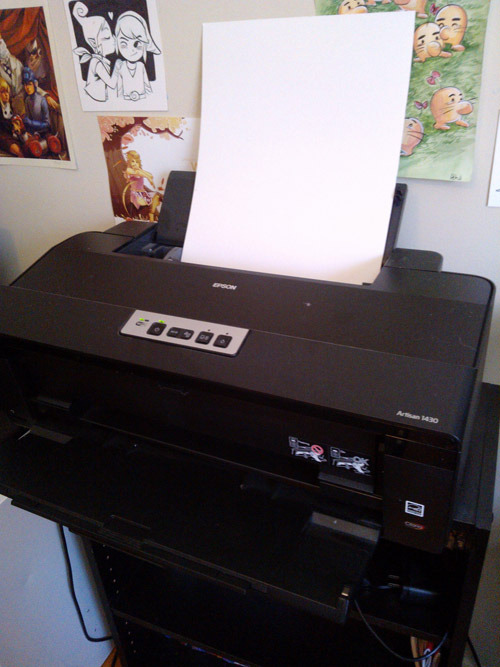
My lovely printer! I do adore it. It’s an Epson Artisan 1430, the size of a keyboard and it’s been great. I printed out 200+ pages of blueline comic pages on only two cartridges of ink.
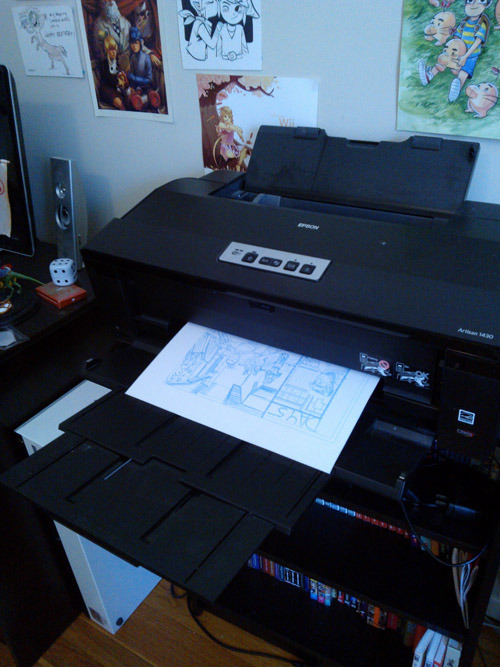
It’s printing!!!
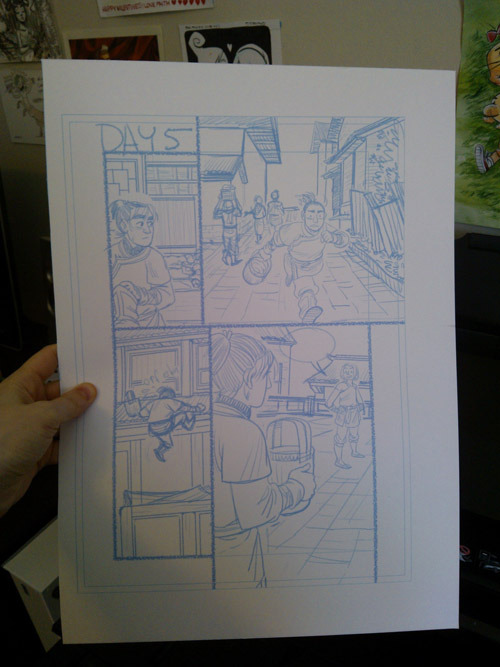
And done! Now for inking.
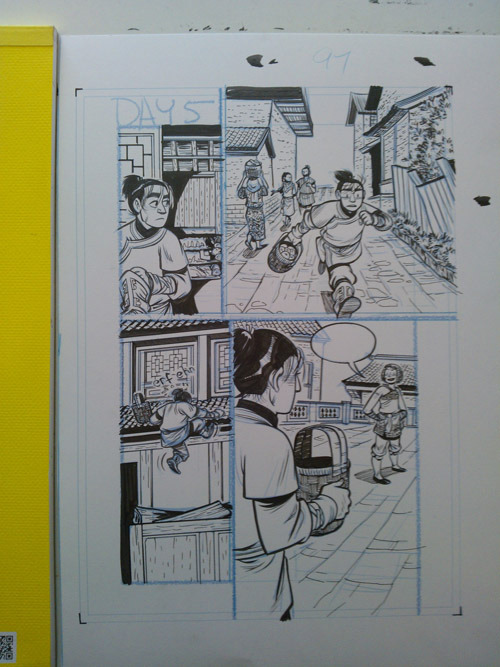
Unfortunately I didn’t take a picture of this page when it was half-done, but here’s the finished product. I don’t ink my borders because I can’t draw a straight line, even with a ruler. 😀 Borders I do in Photoshop.
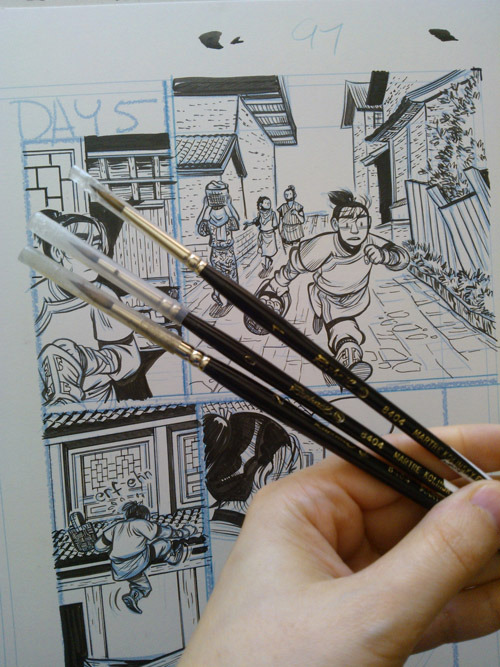
I use a brush for inking. These are the brushes I use: Raphael Kolinsky watercolour brush, sizes 0, 1 & 2. I use the 1 for most of the page, the 0 for finer details and the 2 for larger areas. Anything that’s a straight line is inked with a pen. I tend to use Faber Castel pens, usually a small or extra small.
So that’s pretty much it! After I finish the page I scan it and prep it for printing in Photoshop, which is pretty boring.
The main question I get when I talk about my process is “Why don’t you ink digitally? Then you won’t have to scan.” I would very much like to eliminate scanning from my process, but at this point, I really love inking traditionally. It’s the part of the comic-making process that I enjoy the most, and I also think that traditional inks give my comics their unique look. I’m just not ready to take that step and ink digitally for my graphic novels, although I have done it for shorter comics. Maybe someday, but not now. 🙂 For now, this is how I work.
I hope everyone enjoyed the post, and feel free to shoot me any questions you might have.
Making Comics: Page size advice
reginamantle asked: hi Faith! I’m a big fan of your work, you have a great style and I love seeing the progress posts on The Nameless City. I had a question and I hope it’s okay to ask — at what size do you tend to draw your pages at, and do you have any advice or dos/don’ts when it comes to sizing? (i.e. should one always work at A3 size or can 8.5/11 work too, that sort of thing) thanks in advance, sorry if this is out of place!
Thanks very much! The Nameless City pages are 10 by 14 inches with bleed, which is 1.6 times the size of the book when it will be printed (First Second tends to publish at a standard size of 8.5 by 6 inches). The live area (where important things like speech bubbles should go) on the original pages is 4.875 by 7.5 inches, so they aren’t super big, but big enough. I’m comfortable working at this size. I drew Friends with Boys and Nothing Can Possibly Go Wrong at this size too.
I think whatever size you draw at that is comfortable for you is probably correct, and you needn’t worry about what the “correct” size for drawing comic pages is. I’ve drawn comics at a lot of different sizes. When I did my old webcomics Demonology 101 and Ice, I drew on 8 by 11 inch printer paper. When I drew The Last of Us: American Dreams, Dark Horse sent me Official Comic Paper, which was much bigger than I normally draw, about 11 by 17 inches with (I think) a live area of 10 by 15.
One suggestion, though: I would recommend drawing as small as you can, because that encourages speed. Drawing The Last of Us on huge sheets of paper really slowed me down, because I felt like I should fill every inch of the paper with detail. When I draw smaller, I focus more on what’s really important in the panel (the characters, the composition, the emotion), instead of tiny details that *seem* important when you’re drawing on a giant page, but then aren’t so important once the page is shrunk down and printed. …. soooooo many late nights on that Last of Us comic, drawing bricks, so many bricks, filling the background with bricks, aaaahh. XD
The following is a post I’ve moved over from my Everything is Comics tumblr, which is still online but not actively maintained. Please note the date on the post. Because it is from a few years ago, not all links are up-to-date and not all commentary and details are 100% current. The post is provided as is, for background and general interest. For the latest information, please go to my About, Books and Making Comics sections.
misterloki asked: Typically, how many pages are you able to draw in a good week? I know every artist is different, though! I am trying to gauge an appropriate number I should shoot for, while still giving myself appropriate breaks for sanity’s sake. Thank you for taking your time to look at my question!
Well, I draw comics full time, so my answer will probably not be feasible for most people who maybe have regular jobs/school. I work about 12 hours a day (with a break for supper), six days a week (I take Saturday off) and my quota is 2 pages a day for pencils, 3 pages a day for inks. It varies with each project, though. That’s my quota for The Nameless City, and it’s a hard one to keep up. I usually need most of my 12 hours.
So if I’m on a penciling week, I’m drawing at least 11 pages a week (sometimes I slack a bit on Sundays, unfortunately). If I’m on an inking week, I’m inking about 16-18 pages.
This schedule is kind of hard, though. I’m really behind on my book right now, so I’m pushing myself to catch up. If you can make your deadlines while taking evenings and weekends off, I think that would be ideal.
When I was in school and doing online comics, I’d do maybe 4+ pages a week, which is still a really high number. The pages I drew back then were much smaller than the size I draw at now, and had less backgrounds. I could churn them out a lot faster. Over the five years I was in school full time and drawing online comics, I drew over 750 pages, which is nuts! I didn’t go out much. Also I was single. 😉
I think if you’re doing an online comic and maybe working a job or going to school, doing 10 pages a month is fantastic. That’s a really good pace, because then you’re drawing 120 pages over the course of a year! That’s an entire graphic novel. Even 5 pages a month will give you 60 pages in a year. It really adds up.
I’d suggest working at the speed you feel comfortable with, but always looking for ways to streamline or improve your process. As you become more accustomed to making comics, you’ll get faster and hopefully your work will become more accomplished. However, I am sad to report that despite drawing over 3,000 pages of comics, I still don’t find them easy to make. 😉 I’m always struggling to do better.
amanofletters asked: When you first got into comics, did you feel like you were better at, or more interested in, the drawing or the writing? I want to make my own comics, but I feel like my art straggles behind my writing. How can I cause these two aspects of comic-making to come together within myself, and make the works I want to make?
Oh hey, this is something I think a lot about, actually! So when I started making comics (15 years ago this month, haha), I was really terrible at drawing. And I wanted to do, y’know, GRAPHIC NOVELS, with fairly realistically drawn characters and backgrounds and things that are hard to draw. Things that I didn’t really have the skills to draw at the time. So I’d draw my comics and the art was generally pretty terrible. But I was comfortable with writing, and that helped me keep going with making comics, because I enjoyed the storytelling aspect of them so much.
It’s hard when you feel pretty okay about your writing but your art doesn’t measure up. I kind of feel like my art still doesn’t measure up to what I want it to be (mostly right now I want it to be Hiromu Arakawa, which will never happen, no matter how much I practice), but I’m very comfortable with the writing part of comics, so I look at that as my great strength in my work. It makes up for where my art is lacking, and I work hard at writing to make the sum total of my work better than if I was just writing or just drawing.
I mean, the absolute best thing about comics (to me) is that you don’t need to be a spectacular artist to make really great, involving comics. I’m not an amazing technical artist. During my down times, I don’t draw gorgeous illustrations or do amazing paintings (I kind of dislike doing that kind of thing, to be honest). I will never be Gillian Tamaki. But I’m good at storytelling, and I’m good at interpreting emotion and drawing that on the comic page. So I work to my strengths, which is making stories about engaging characters, and laying out scenes where there is a lot of emotion running through them, and people who like my comics don’t seem to mind that my art is not as great as Gillian Tamaki or Hiromu Arakawa.
Comics aren’t just art or just writing, they’re the two combined to make something new and wonderful. They are more than the sum of their parts. So work hard to because a decent artist with a good grasp of storytelling basics (this is super important!), and work harder to become a truly excellent writer and storyteller, and you can quite possibly make great comics! It worked for me. 🙂
Making Comics: Applying for grants
draw-blog asked: Hi there, I’m a Canadian cartoonist interested in applying for some grants to make comics. I’ve heard that you have received some grants (apart from the now discontinued Xeric) to make comics and I was wondering if you could specify which ones, or talk a little bit about the process? Thanks a whole bunch!
The Canadian government has several grant programs to support the arts within Canada. I’ve gotten grants to make comics at both the provincial and federal level. These allowed me to continue working full time in comics during a very shaky financial period in my life.
The federal grant program in Canada is overseen by the Canada Council for the Arts. They support a variety of work from dance to sculpture to prose to comics. I’m actually not sure of all of the varieties they support, but it’s quite a lot. The grant for Creative Writing includes graphic novels, so if you are a cartoonist, you can apply for a grant to work on a comic. However, there are eligibility criteria to fulfill, so make sure you read that carefully to find out if your work is actually eligible for a grant.
The provincial grant programs vary from province to province. I got one from the Nova Scotia Communities, Cultures & Heritage grant program, to write and draw Friends with Boys. I would suggest googling to see what kind of grants are available to you in your province. I tend to suspect that there are less applicants on a provincial level; the Canada Arts Council is well know, and competition to get a grant is very strong at that level.
As for actually getting a grant, my advice is to make your application as strong as possible. If you are applying to do a graphic novel, include samples of that graphic novel, so the people on the grant jury can see your work and see what you want to achieve. Ask for the maximum amount of money available to your category, as you don’t get points for asking for less. Also, the grant jury changes every year, so if you fail to get a grant with a certain project, you can re-apply with that same project at a later date and it may be successful. But remember to make your application as strong as possible! You are pitching people on the merit of your work, and asking them to invest financially in it.
Good luck!!!!!!
